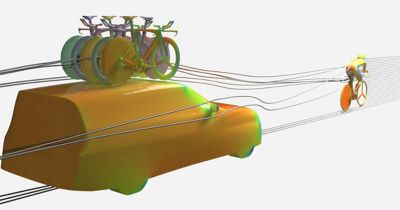Every four years, the world’s best athletes come together to represent their nations in the Summer Games. The first written record of the Games was in 776 B.C., when they were held to honor the Greek god Zeus. After a 1,500-year hiatus — 393 A.D. to 1896 — the Games as we know them were reintroduced in Athens, Greece, and have since become the pinnacle of sportsmanship and universality.
The Games have come a long way, from hosting only 10 sporting events in 1896 to boasting more than 45 categories today, with different disciplines in each. Events were added over the years, such as equestrian in 1900, table tennis in 1988, and skateboarding in 2021, but some events hearken back to ancient Greece. Long jump has been part of the Games since the beginning and remains one of the most watched events. Not much about long jump has changed since 776 B.C., except jumpers no longer hold weights to increase momentum. The simple goal remains the same: Jump the farthest. But modern-day long jump is much more technical than before.
Long jump is composed of four phases: approach, takeoff, flight, and landing.
1. Approach: The approach is essentially a sprint toward the takeoff point. At professional levels, jumpers take about 20 to 22 steps.
2. Takeoff: A jumper wants her or his foot to be flat for optimum impact and as close as possible to the takeoff line.
Watch Long Jump at the 2024 Summer Games!
Sunday, Aug. 4
- 5 a.m. Eastern time: men’s long jump qualification
Tuesday, Aug. 6
- 5:15 a.m. Eastern time: women’s long jump qualification
- 2:20 p.m. Eastern time: men’s long jump final
Thursday, Aug. 8
- 2 p.m. Eastern time: women’s long jump final
3. Flight: Three common techniques extend flight time, which increases overall jump length.
- Stride: Jumpers lift one of their legs into a toe-touching position after takeoff.
- Hitch kick: Jumpers rotate their arms and legs during flight to maintain balance.
- Hang: Jumpers extend both arms and legs until they reach the highest elevation, and then they put their legs forward into a landing position.
4. Landing: The goal is to glide into the sandpit rather than drop into it. Jumpers keep their feet in front of their bodies and then “sweep” with their arms.

The phases for three different jump styles: (a) stride, (b) hitch kick, and (c) hang. Image credit: professor Bert Blocken, Heriot-Watt University and KU Leuven.
With so many moving parts happening in quick succession, it’s no surprise that long jump is considered one of the hardest athletic events to master. And that assumption doesn’t take environmental factors into consideration. Wind speed, altitude, temperature, air pressure, and humidity all play a part in whether a long jumper sets a personal record or is scratched from the event. We unfortunately can’t control weather, but there are factors that athletes have complete control over: their clothing and hairstyles.
“We’ve seen a lot of different hair and clothing styles in professional long jumps over the years,” says aerodynamics professor Bert Blocken of Heriot-Watt University in the United Kingdom and KU Leuven in Belgium. “From long ponytails and tight shorts to free-flowing curls and loose shirts, these stylistic choices can have an impact on overall performance.”
With input from professors and engineers at Ansys, the University of Southampton, Oxford Brookes University, Tailormold, and the Avicenna Alliance Association for Predictive Medicine, Blocken wanted to find out how much clothing and hairstyles impact the performance of flight, as about 90% of the total jump distance comes from this phase. With the help of Ansys Fluent fluid simulation software and the University of Southampton’s wind tunnels, he and his team published the first study to focus on this topic.
Not So Fast
While this has been extensively studied in other sports, such as cycling, skiing, and speed skating, long-jumping coaches and athletes often assume that the speed at which humans can sprint and jump is too slow for clothing or hair to impact aerodynamics. Blocken and his team believe this to be an incorrect assumption.
The study was based on an imaginary 1.8 m (5 ft., 10.9 in.) woman weighing 70 kg (154.3 lbs.), as women typically have more hairstyles than men. The model, created by Phillipe Laguna at Ansys, had no hair and wore tight-fitting shorts, a top, and running shoes. The team replicated different postures that jumpers make during flight for the three different jump styles.
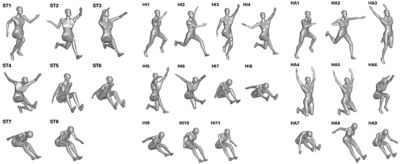
Eight consecutive positions of the stride jump (left), 11 consecutive positions of the hitch kick jump (middle), and nine consecutive positions of the hang jump (right). Image credit: professor Bert Blocken, Heriot-Watt University and KU Leuven.
To validate these models, the team created quarter-scale manikins in several of the above postures and took them to the University of Southampton’s wind tunnel. The team then performed computational fluid dynamics (CFD) simulations in Fluent software on the same five postures from the wind tunnel study. The researchers found that the deviations between the two studies were extremely small.
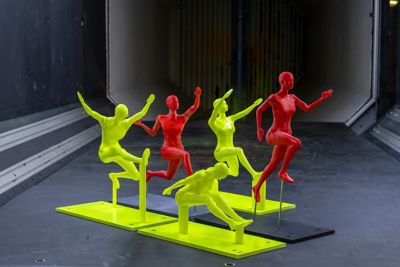
Five quarter-scale wind tunnel manikins of postures of the stride jump. Image credit: professor Bert Blocken, Heriot-Watt University and KU Leuven.
After validating the mini manikins, Blocken and his team performed CFD simulations to determine drag, lift, and moment of area for all 28 postures at full scale. Then it was time to hit the wind tunnel again with a full-size manikin for a “fashion show.” The team took a total of 200 measurements from 10 hairstyle and 20 clothing style combinations.

Three hairstyle and clothing style variations inside the wind tunnel. Image credit: professor Bert Blocken, Heriot-Watt University and KU Leuven.
The Difference Between a Podium Finish and Last Place
In sprinting events, the difference among first, second, and third place can come down to hundredths of a second. It’s why sprinters sometimes lean forward as they cross the finish line, especially in close races. The lean can help them cross the finish line first, gaining the tiniest advantage over competitors. The same can be said for long jump, with placings coming down to a quarter of an inch or half a centimeter. Blocken and his team determined that loose-fitting shorts and tops can increase drag by up to 25%, with losses of 10 cm or more. Tight-fitting tops and bottoms could actually decrease drag by almost 10%, but tops and bottoms that were too tight would increase drag. Hairstyle played a smaller role, but every style increased drag. Even a tight, slicked-back bun at the base of the neck increased drag by 2.3%.
These numbers might not seem that large, but at the professional level, 10 cm is enormous. The difference among first, second, and third place for the women’s long jump at the 2020 Summer Games was only 3 cm.
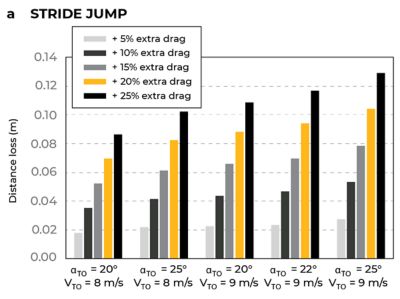
Flight distance loss due to 5%, 10%, 15%, 20%, and 25% extra drag caused by hairstyle and/or clothing for the stride jump. Image credit: professor Bert Blocken, Heriot-Watt University and KU Leuven.
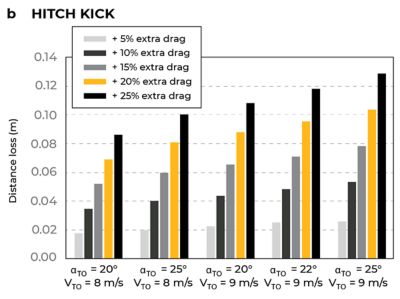
Flight distance loss due to 5%, 10%, 15%, 20%, and 25% extra drag caused by hairstyle and/or clothing for the hitch kick jump. Image credit: professor Bert Blocken, Heriot-Watt University and KU Leuven.
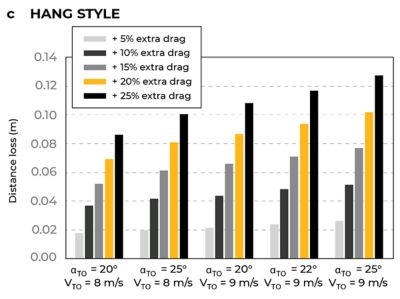
Flight distance loss due to 5%, 10%, 15%, 20%, and 25% extra drag caused by hairstyle and/or clothing for the hang jump. Image credit: professor Bert Blocken, Heriot-Watt University and KU Leuven.
Slow and Steady Wins the Race
Blocken and his team by no means recommend that athletes cut their hair. Instead, long jumpers should consider wearing caps, much like a swim cap, and low-drag clothing to reduce aerodynamic resistance. But because this is the first published study on the topic, he doesn’t anticipate these changes taking hold soon. “Even the introduction of helmets in cycling took many years; initially the riders protested wearing helmets,” he says. In time and as more studies about the benefits are published, he believes we will begin to see hair caps and wind tunnel-tested clothing making their way into professional long jump. But he stresses the freedom of athletes to compete as they want.

Computational grid for the full-scale model in posture four of the stride jump (ST4) (12,222,382 cells)
Learn how Fluent software helped determine the effects of hairstyles and clothing styles on long jump flights by reading the full study.
Just for you. We have some additional resources you may enjoy.
“We’ve seen a lot of different hair and clothing styles in professional long jumps over the years. From long ponytails and tight shorts to free-flowing curls and loose shirts, these stylistic choices can have an impact on overall performance.”
— Bert Blocken, aerodynamics professor















